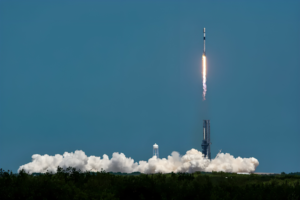
SpaceX is the fastest-growing space company worldwide, achieving major successes since its inception in 2002. Its technical execution has set a benchmark for the newspace community and serves as a model for countless startups in the sector.
Incumbent players in the launch sector initially viewed SpaceX with skepticism, then incredulity, and now with awe, as the company unfolded its business model. Today, it is widely recognized that SpaceX, with its partially reusable Falcon launch system, has significantly reduced the cost of orbital launches.
However, despite these cost reductions, customers of SpaceX are not yet benefiting from any significant reduction in the cost of access to space. The economies achieved by SpaceX are irrevocably tied to the company’s success and provide the foundation for Starlink’s seemingly unstoppable development.
The Business of SpaceX
1. Space Launch
SpaceX operates in three main market segments: Starlink launches (80% of the total), United States government launches (NASA and DoD), and commercial and export launches (SES, OneWeb, ESA). This launch business is highly profitable due to SpaceX’s reusability technology, which drives down costs and generates gross margins on every launch performed for external customers. It is estimated that SpaceX’s launch business will yield about $3.5 billion in revenues in 2024, with about 20 to 25 launches per year.
2. Broadband Service
Through its 6,000-satellite Starlink constellation, SpaceX delivers global broadband access to fixed and mobile terminals around the globe. This business is expected to yield about $4.5 billion in 2024, with 80% of this being service revenue and the rest from terminal sales. Analysts recognize that for Starlink to break even and turn a profit, SpaceX must achieve very low Capex, with each Starlink launch costing less than $50 million.
3. Satellite Supplier
SpaceX supplies satellites for U.S. government constellations, such as the Space Development Agency’s Proliferated Warfighter Space Architecture transport layer and the Starshield constellation. The actual revenue from these projects is unknown, but it is reasonable to assume they may yield $500 million and upwards in 2023 and 2024.
4. HLS Program
SpaceX is involved in NASA’s Artemis program as a supplier of the Human Landing System (HLS) to land U.S. astronauts on the moon. It is likely that SpaceX already recognized large revenues from these contracts, perhaps $700 million to $800 million a year.
Modeling SpaceX Financials
Eurospace has designed its own SpaceX financial model to understand the intertwined dynamics of SpaceX revenues and expenditures. One key assumption considers the actual costs of Falcon 9 launches, which drive average launch costs down due to reusability, growing booster reuse rates, and decreased refurbishment times.
In 2021, Eurospace concluded that the reusability model generates large, growing profits at scale after the seventh launch of the year. In 2024, the reusability model has vastly improved, with many analysts believing that the full cost of each Falcon 9 launch is currently below $30 million. Eurospace prefers a conservative estimate of $28 million per launch.
Low-Cost Access to Space: A Catalyst for Newspace and Competitive Advantage
SpaceX has managed to significantly lower the cost of access to space but has no incentive to offer lower prices due to the competition’s dire situation. Some competitors have suggested that SpaceX may be selling below costs to undercut them, but the assumption that Falcon 9’s full cost per launch is higher than $30 million does not align with Starlink’s deployment cadence.
SpaceX’s Competitive Advantage: Fair Game or Excessive Markup?
For instance, Amazon’s Kuiper launch plans could benefit from lower Capex if they had access to the same launch deal as Starlink. U.S. government customers may also question whether they are getting fair pricing from SpaceX.
SpaceX’s success highlights the importance of achieving low-cost access to space and the potential benefits it can bring to humanity.
For more information on the Technology, you can follow us on Americana Pulse Technology.
